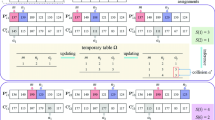Abstract
This paper proposes a color image encryption scheme using one-time keys based on crossover operator, chaos and the Secure Hash Algorithm(SHA-2). The (SHA-2) is employed to generate a 256-bit hash value from both the plain-image and the secret hash keys to make the key stream change in each encryption process. The SHA-2 value is employed to generate three initial values of the chaotic system. The permutation-diffusion process is based on the crossover operator and XOR operator, respectively. Experimental results and security analysis show that the scheme can achieve good encryption result through only one round encryption process, the key space is large enough to resist against common attacks,so the scheme is reliable to be applied in image encryption and secure communication.









Similar content being viewed by others
References
Algredo-Badillo I, Feregrino-Uribe C, Cumplido R b, Morales-Sandoval M (2013) FPGA-based implementation alternatives for the inner loop of the Secure Hash Algorithm SHA-256. Microprocess Microsyst 37:750–757
Alvarez G, Montoya F, Romera M, Pastor G (2003) Cryptanalysis of an ergodic chaotic cipher. Physics Letters A 311:172–179
Arroyo D, Rhouma R, Alvarez G, Li S, Fernandez V (2008) On the security of a new image encryption scheme based on chaotic map lattices. Chaos Interdiscip J Nonlinear Sci 18:033112
Arroyo D, Alvarez G, Amigo J M, Li S (2011) Cryptanalysis of a family of self-synchronizing chaotic stream ciphers. Commun Nonlinear Sci Numer Simul 16:2805–813
Chang CC, Yu TX (2002) Cryptanalysis of an encryption scheme for binary images. Pattern Recognit Lett 23:1847–1852
Cokal C, Solak E (2009) Cryptanalysis of a chaos-based image encryption algorithm. Phys Lett A 373:1357–1360
(2010) European Network of Excellence in Cryptology II. http://www.ecrypt.eu.org
Federal Information Processing Standards Publication 180-2, Announcing the Secure Hash Standard. US DoC/NIST, August (2002)
Fridrich J (1998) Symmetric ciphers based on two-dimensional chaotic maps. Int J of Bifurcation and Chaos 8:1259–1284
Holland JH (1975) Adaptation in natural and artificial systems. University of Michigan Press, p 183
Holland JH (1992) Genetic algorithms. Sci Am 267(l):44–50
Kanso A, Ghebleh M (2012) A novel image encryption algorithm based on a 3D chaotic map. Commun Nonlinear Sci Numer Simulat 17:2943–2959
Lian S, Sun J, Wang Z (2005) A block cipher based on a suitable use of the chaotic standard map. Chaos Solitons Fract 26:117–129
Li C, Arroyo D, Lo K T (2010) Breaking a chaotic cryptographic scheme based on composition maps. International Journal of Bifurcation and Chaos 20(8):2561–2568
Liu H, Wang X (2010) Color image encryption based on one-time keys and robust chaotic maps. Comput Math Appl 59:3320–3327
Ramasubramanian K, Sriram MS (2000) A comparative study of computation of Lyapunov spectra with different algorithms. Physica D 139(1–2):72–86
Rhouma R, Solak E, Arroyo D, Li S, Alvarez G, Belghith S (2008) Comment on Modified Baptista type chaotic cryptosystem via matrix secret key. Physical Letters A 372:5427; Physics Letters A 373, 3398–3400 (2009)
Solak E, Cokal C, Yildiz OT, Biyikoglu T (2010) Cryptanalysis of Fridrichs chaotic image encryption. International Journal of Bifurcation and Chaos 20(5):1405–1413
Solak E, Cokal C (2011) Algebraic break of image ciphers based on discretized chaotic map lattices. Information Sciences 181(1):227–233
Tang Y, Wang Z, Fang J (2010) Image encryption using chaotic coupled map lattices with time-varying delays. Commun Nonlinear Sci Numer Simulat 15:2456–2468
Wong K, Kwok B, Law W (2008) A fast image encryption scheme based on chaotic standard map. Phys Lett A 372:2645–2652
Wang X, Teng L, Qin X (2012) A novel colour image encryption algorithm based on chaos. Signal Process 92:11011108
Xiao D, Liao XF, Wei PC (2009) Analysis and improvement of a chaos-based image encryption algorithm. Chaos Solitons Fract 40:2191–2199
Ye R (2011) A novel chaos-based image encryption scheme with an efficient permutation-diffusion mechanism. Opt Commun 284:5290–5298
Zhou Q, Wong KW, Liao XF, Xiang T, Hu Y (2008) Parallel image encryption algorithm based on discretized chaotic map. Chaos Solitons Fract 38:1081–1092
Author information
Authors and Affiliations
Corresponding author
Rights and permissions
About this article
Cite this article
Guesmi, R., Ben Farah, M., Kachouri, A. et al. Hash key-based image encryption using crossover operator and chaos. Multimed Tools Appl 75, 4753–4769 (2016). https://doi.org/10.1007/s11042-015-2501-0
Received:
Revised:
Accepted:
Published:
Issue Date:
DOI: https://doi.org/10.1007/s11042-015-2501-0



